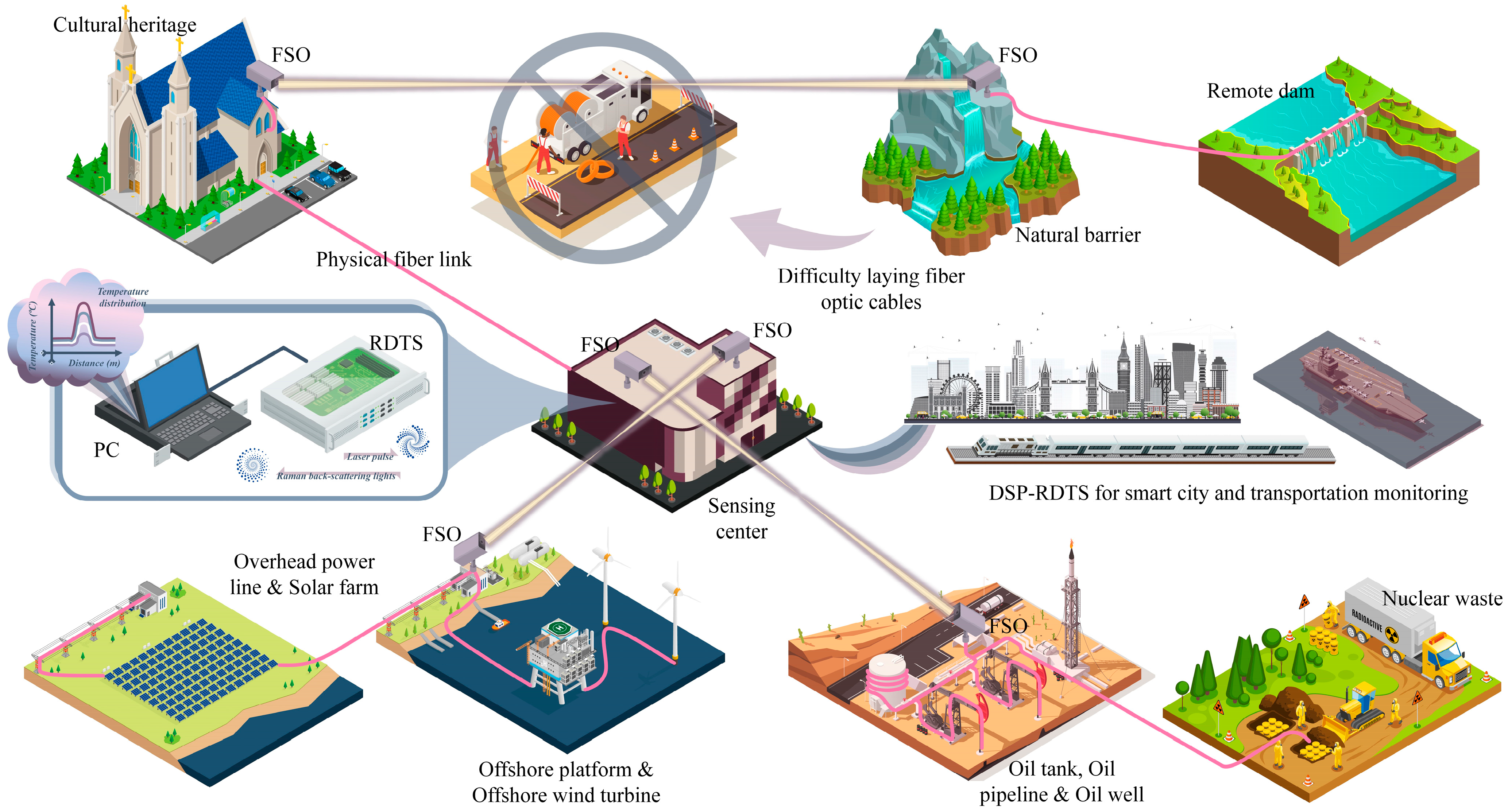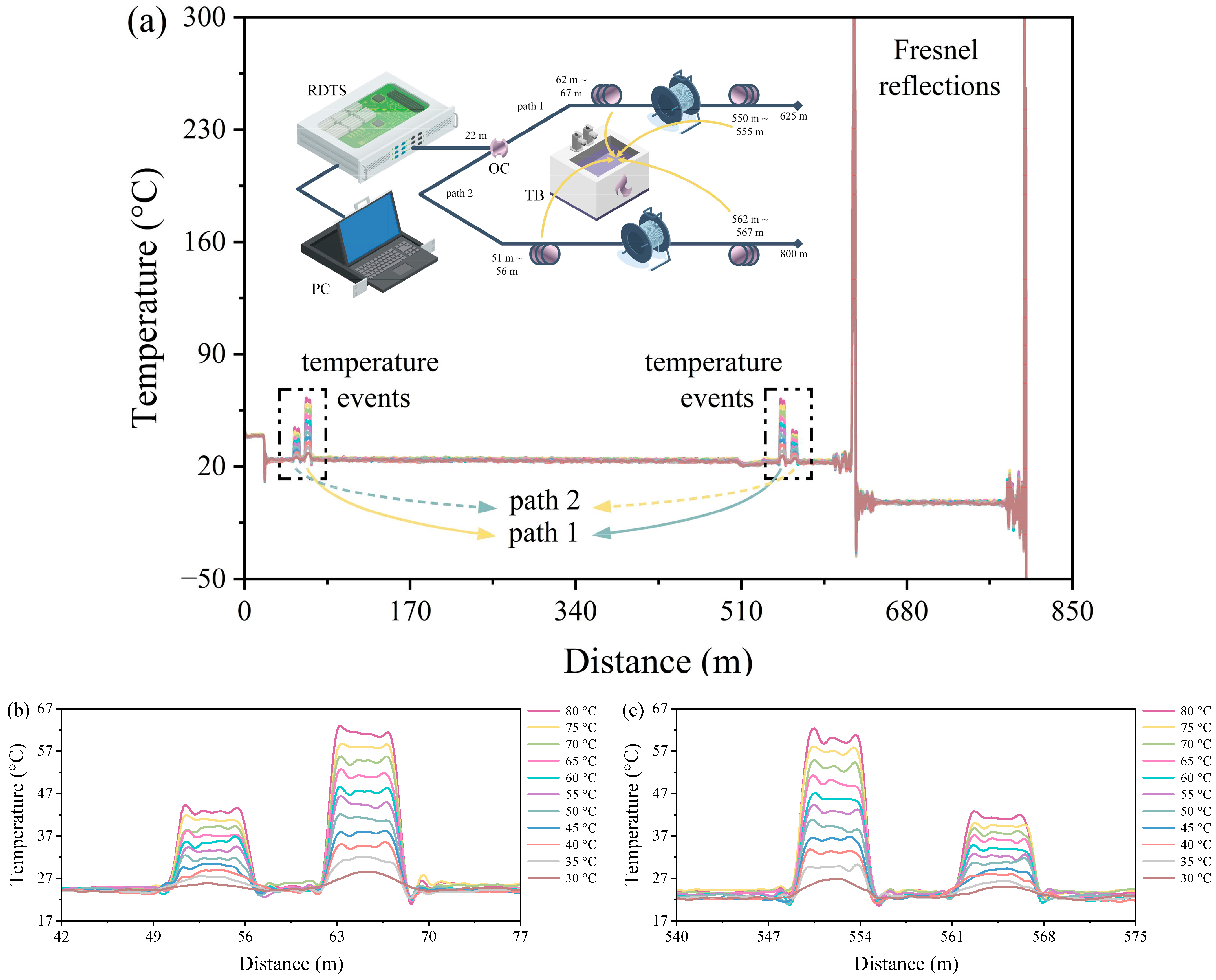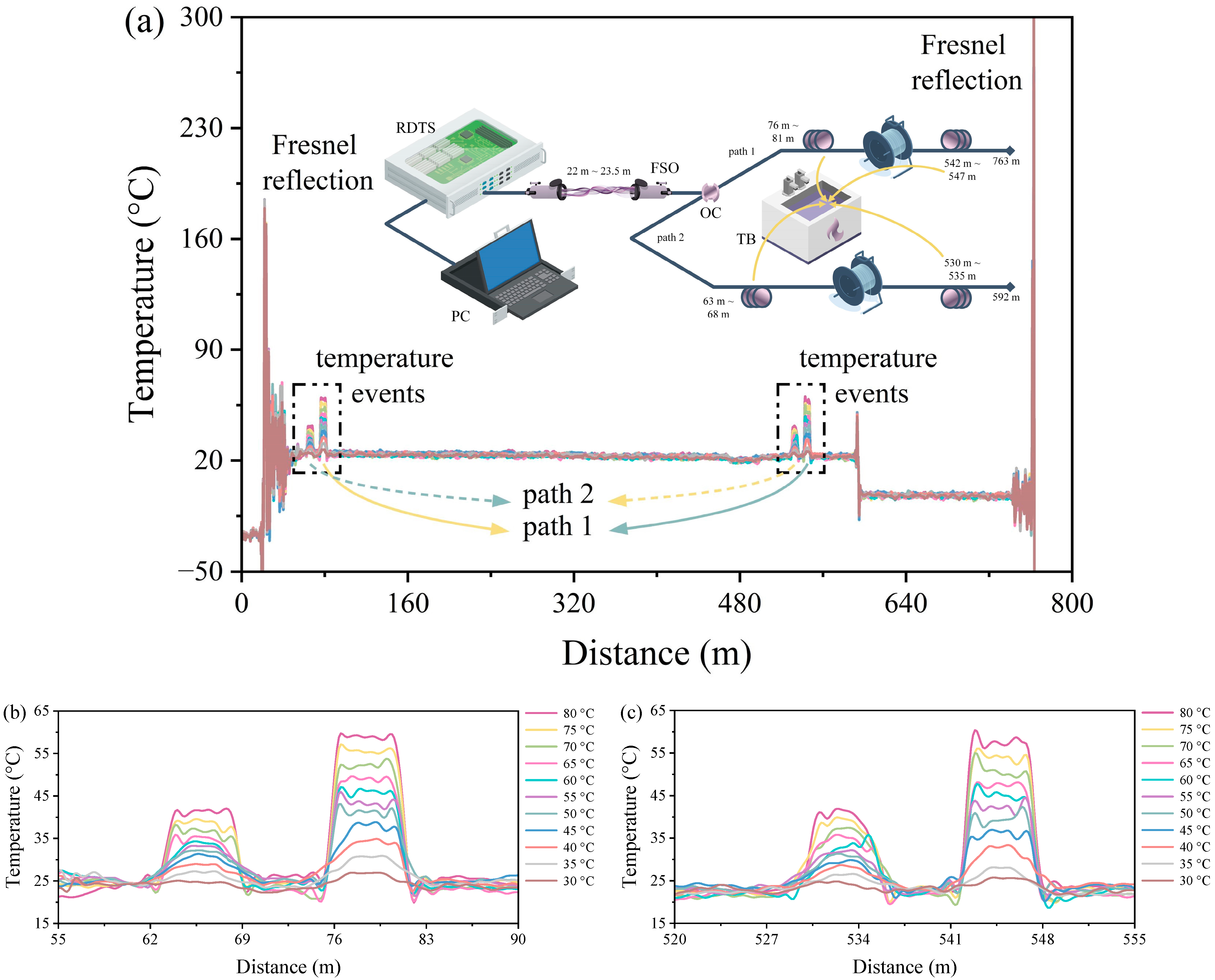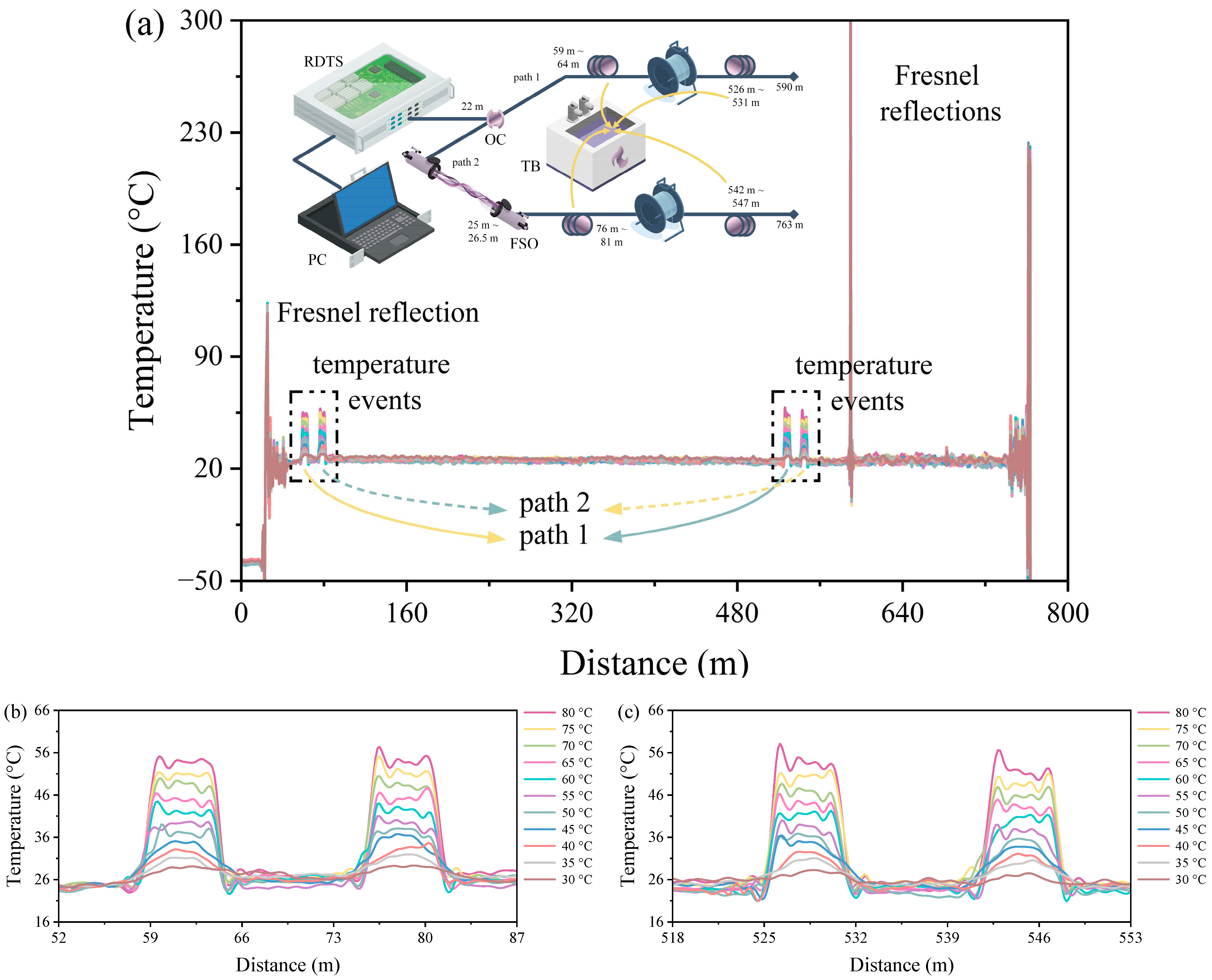One Raman DTS Interrogator Channel Supports a Dual Separate Path to Realize Spatial Duplexing
Abstract
:1. Introduction
2. RDTS and Overview
3. Experiments and Discussions
3.1. DSP–RDTS Scheme
3.2. DSP–RDTS with FSO Scheme
3.3. DSP–RDTS with FSO within One Path Scheme
3.4. DSP–RDTS with Sub-DSP within One Path Scheme
4. Conclusions
Author Contributions
Funding
Institutional Review Board Statement
Informed Consent Statement
Data Availability Statement
Conflicts of Interest
References
- Grattan, K.T.; Sun, T. Meeting industrial needs with optical fiber sensors. In Proceedings of the Optical Fiber Communication Conference (OFC), San Francisco, CA, USA, 6–10 June 2021. [Google Scholar]
- Liu, H.; Hu, D.J.J.; Sun, Q.; Wei, L.; Li, K.; Liao, C.; Li, B.; Zhao, C.; Dong, X.; Tang, Y.; et al. Specialty optical fibers for advanced sensing applications. Opto-Electron. Sci. 2023, 2, 220025. [Google Scholar] [CrossRef]
- Pendão, C.; Silva, I. Optical fiber sensors and sensing networks: Overview of the main principles and applications. Sensors 2022, 22, 7554. [Google Scholar] [CrossRef] [PubMed]
- Jayawickrema, U.M.N.; Herath, H.M.C.M.; Hettiarachchi, N.K.; Sooriyaarachchi, H.P.; Epaarachchi, J.A. Fibre-optic sensor and deep learning-based structural health monitoring systems for civil structures: A review. Measurement 2022, 199, 111543. [Google Scholar] [CrossRef]
- Vorathin, E.; Hafizi, Z.M.; Ismail, N.; Loman, M. Review of high sensitivity fibre-optic pressure sensors for low pressure sensing. Opt. Laser Technol. 2020, 121, 105841. [Google Scholar] [CrossRef]
- Elsherif, M.; Salih, A.E.; Muñoz, M.G.; Alam, F.; AlQattan, B.; Antonysamy, D.S.; Zaki, M.F.; Yetisen, A.K.; Park, S.; Wilkinson, T.D.; et al. Optical fiber sensors: Working principle, applications, and limitations. Adv. Photon. Res. 2022, 3, 2100371. [Google Scholar] [CrossRef]
- Singh, M.J.; Choudhary, S.; Chen, W.B.; Wu, P.C.; Goyal, M.K.; Rajput, A.; Borana, L. Applications of fibre Bragg grating sensors for monitoring geotechnical structures: A comprehensive review. Measurement 2023, 218, 113171. [Google Scholar] [CrossRef]
- Leal-Junior, A.; Avellar, L.; Blanc, W.; Frizera, A.; Marques, C. Opto-electronic smart home: Heterogeneous optical sensors approaches and artificial intelligence for novel paradigms in remote monitoring. IEEE Internet Things J. 2023, 11, 9587–9598. [Google Scholar] [CrossRef]
- Sa’ad, M.S.M.; Ahmad, H.; Alias, M.A.; Zaini, M.K.A.; Samion, M.Z.; Grattan, K.T.; Rahman, B.M.A.; Brambilla, G.; Lim, K.S.; Harun, S.W. Optical fiber Bragg grating-based pressure sensor for soil monitoring applications. Opt. Eng. 2023, 62, 086101. [Google Scholar] [CrossRef]
- Wang, H.; Zheng, J.; Nie, Q.; Zhao, C.; Wang, Z.; Kumar, S.; Marques, C.; Min, R.; Hu, X. SleepSense: Smart pillow with pressure-sensitive FBG-embedded silicone buttons. IEEE Sens. J. 2023, 23, 19324–19331. [Google Scholar] [CrossRef]
- Chiang, L.W.; Lou, Y.J.; Wang, L. Fiber-optic multi-zone intrusion detection system based on Fabry-Perot interferometers with fiber Bragg gratings. IEEE Sens. J. 2024, 24, 10056–10067. [Google Scholar] [CrossRef]
- Arockiyadoss, M.A.; Dehnaw, A.M.; Manie, Y.C.; Hayle, S.T.; Yao, C.K.; Peng, C.H.; Kumar, P.; Peng, P.C. Self-healing fiber Bragg grating sensor system using free-space optics link and machine learning for enhancing temperature measurement. Electronics 2024, 13, 1276. [Google Scholar] [CrossRef]
- Kashaganova, G.; Kozbakova, A.; Kartbayev, T.; Balbayev, G.; Togzhanova, K.; Alimseitova, Z.; Orazaliyeva, S. Research of a fiber sensor based on fiber Bragg grating for road surface monitoring. Electronics 2023, 12, 2491. [Google Scholar] [CrossRef]
- Jati, M.P.; Luthfi, M.I.; Yao, C.K.; Dehnaw, A.M.; Manie, Y.C.; Peng, P.C. An extremely close vibration frequency signal recognition using deep neural networks. Appl. Sci. 2024, 14, 2855. [Google Scholar] [CrossRef]
- Novais, S.; Silva, S.O.; Frazão, O. Curvature detection in a medical needle using a Fabry-Perot cavity as an intensity sensor. Measurement 2020, 151, 107160. [Google Scholar] [CrossRef]
- Novais, S.; Ferreira, M.S.; Pinto, J.L. Relative humidity fiber sensor based on multimode interferometer coated with agarose-gel. Coatings 2018, 8, 453. [Google Scholar] [CrossRef]
- Zhao, X.; Chen, K.; Guo, M.; Li, C.; Li, C.; Zhang, G.; Gong, Z.; Zhou, Z.; Peng, W. Ultra-high sensitive multi-pass absorption enhanced fiber-optic photoacoustic gas analyzer. IEEE Trans. Instrum. Meas. 2022, 72, 1–8. [Google Scholar]
- Suo, L.; Peng, Y.P.; Yao, C.K.; Ren, S.; Lu, X.; Chen, N.K. High sensitivity strain sensors using four-core fibers through a corner-core excitation. Micromachines 2022, 13, 431. [Google Scholar] [CrossRef] [PubMed]
- Lei, X.; Dong, X.; Lu, C.; Sun, T.; Grattan, K.T.V. Underwater pressure and temperature sensor based on a special dual-mode optical fiber. IEEE Access 2020, 8, 146463–146471. [Google Scholar] [CrossRef]
- Lu, C.; Su, J.; Dong, X.; Sun, T.; Grattan, K.T.V. Simultaneous measurement of strain and temperature with a few-mode fiber-based sensor. J. Light. Technol. 2018, 36, 2796–2802. [Google Scholar] [CrossRef]
- Lu, C.; Su, J.; Dong, X.; Lu, l.; Sun, T.; Grattan, K.T.V. Studies on temperature and strain sensitivities of a few-mode critical wavelength fiber optic sensor. IEEE Sens. J. 2018, 19, 1794–1801. [Google Scholar] [CrossRef]
- Dejband, E.; Yao, C.K.; Manie, Y.C.; Huang, P.Y.; Lee, H.K.; Tan, T.H.; Peng, P.C. Utilizing a tunable delay line interferometer to improve the sensing accuracy of an FBG sensor system. Photonics 2022, 9, 869. [Google Scholar] [CrossRef]
- Lu, P.; Lalam, N.; Badar, M.; Liu, B.; Chorpening, B.T.; Buric, M.P.; Ohodnicki, P.R. Distributed optical fiber sensing: Review and perspective. Appl. Phys. Rev. 2019, 6, 041302. [Google Scholar] [CrossRef]
- Li, J.; Zhang, M. Physics and applications of Raman distributed optical fiber sensing. Light Sci. Appl. 2022, 11, 128. [Google Scholar] [CrossRef] [PubMed]
- Silva, L.C.; Segatto, M.E.; Castellani, C.E. Raman scattering-based distributed temperature sensors: A comprehensive literature review over the past 37 years and towards new avenues. Opt. Fiber Technol. 2022, 74, 103091. [Google Scholar] [CrossRef]
- Toda, K.; Otsubo, K.; Noda, K.; Lee, H.; Nakamura, K.; Mizuno, Y. Fiber-optic temperature probe based on low-coherence Brillouin optical correlation-domain reflectometry. Opt. Fiber Technol. 2023, 81, 103435. [Google Scholar] [CrossRef]
- Leandro, D.; Zhu, M.; López-Amo, M.; Murayama, H. Quasi-distributed vibration sensing based on weak reflectors and STFT demodulation. J. Light. Technol. 2020, 38, 6954–6960. [Google Scholar] [CrossRef]
- Fernandez, I.; Berrocal, C.G.; Rempling, R. Two-dimensional strain field analysis of reinforced concrete D-regions based on distributed optical fibre sensors. Eng. Struct. 2023, 278, 115562. [Google Scholar] [CrossRef]
- Yao, C.K.; Lin, T.C.; Chen, H.M.; Hsu, W.Y.; Manie, Y.C.; Peng, P.C. Inclination measurement adopting Raman distributed temperature sensor. IEEE Sens. J. 2023, 23, 22543–22555. [Google Scholar] [CrossRef]
- Yao, C.K.; Manie, Y.C.; Chen, H.M.; Hsu, W.Y.; Lin, T.C.; Peng, P.C. Involvement of free-space optics in Raman distributed temperature sensing. Opt. Lett. 2023, 48, 6340–6343. [Google Scholar] [CrossRef]
- Zhou, X.; Wang, F.; Yang, C.; Zhang, Z.; Zhang, Y.; Zhang, X. Hybrid distributed optical fiber sensor for the multi-parameter measurements. Sensors 2023, 23, 7116. [Google Scholar] [CrossRef]
- Yao, C.K.; Lin, H.P.; Cheng, C.L.; Li, Y.L.; Du, L.Y.; Peng, P.C. Satellite communication and free space optics for open radio access network. J. Light. Technol. 2024, 42, 3546–3553. [Google Scholar] [CrossRef]
- Dehnaw, A.M.; Manie, Y.C.; Du, L.Y.; Yao, C.K.; Jiang, J.W.; Liu, B.X.; Peng, P.C. Integrated sensor-optics communication system using bidirectional fiber and FSO channels and hybrid deep learning techniques. Sensors 2023, 23, 8434. [Google Scholar] [CrossRef] [PubMed]
- Manie, Y.C.; Yao, C.K.; Peng, P.C. Free-space optical and optical Networks. In Handbook of Radio and Optical Networks Convergence; Springer Nature: Singapore, 2024. [Google Scholar]
- Yeh, C.H.; Lin, W.P.; Jiang, S.Y.; Hsieh, S.E.; Hsu, C.H.; Chow, C.W. Integrated fiber-FSO WDM access system with fiber fault protection. Electronics 2022, 11, 2101. [Google Scholar] [CrossRef]
- Yeh, C.H.; Ko, H.S.; Liaw, S.K.; Liu, L.H.; Chen, J.H.; Chow, C.W. A survivable and flexible WDM access network by alternate FSO-and fiber-paths for fault protection. IEEE Photonics J. 2022, 14, 1–5. [Google Scholar] [CrossRef]
- Van de Giesen, N.; Steele-Dunne, S.C.; Jansen, J.; Hoes, O.; Hausner, M.B.; Tyler, S.; Selker, J. Double-ended calibration of fiber-optic Raman spectra distributed temperature sensing data. Sensors 2012, 12, 5471–5485. [Google Scholar] [CrossRef] [PubMed]
- Hughes, T.; Henstock, T.; Pilgrim, J.; Dix, J.; Gernon, T.; Thompson, C. Thermal ratings of submarine HV cables informed by environmental considerations. In Proceedings of the 9th International Conference on Insulated Power Cables, Versailles, France, 21–25 June 2015. [Google Scholar]
- Hermansen, C.H. Using Deep Learning for Anomaly Detection in Distributed Temperature Sensing Systems for Submarine Export Cables. Master’s Thesis, Norwegian University of Science and Technology, Trondheim, Norway, 2019. [Google Scholar]
- Soto, M.A.; Nannipieri, T.; Signorini, A.; Lazzeri, A.; Baronti, F.; Roncella, R.; Bolognini, G.; Di Pasquale, F. Raman-based distributed temperature sensor with 1 m spatial resolution over 26 km SMF using low-repetition-rate cyclic pulse coding. Opt. Lett. 2011, 36, 2557–2559. [Google Scholar] [CrossRef]
- Sun, X.; Yang, Z.; Hong, X.; Zaslawski, S.; Wang, S.; Soto, M.A.; Gao, X.; Wu, J.; Thévenaz, L. Genetic-optimised aperiodic code for distributed optical fibre sensors. Nat. Commun. 2020, 11, 5774. [Google Scholar] [CrossRef]










Disclaimer/Publisher’s Note: The statements, opinions and data contained in all publications are solely those of the individual author(s) and contributor(s) and not of MDPI and/or the editor(s). MDPI and/or the editor(s) disclaim responsibility for any injury to people or property resulting from any ideas, methods, instructions or products referred to in the content. |
© 2024 by the authors. Licensee MDPI, Basel, Switzerland. This article is an open access article distributed under the terms and conditions of the Creative Commons Attribution (CC BY) license (https://creativecommons.org/licenses/by/4.0/).
Share and Cite
Yao, C.-K.; Peng, C.-H.; Chen, H.-M.; Hsu, W.-Y.; Lin, T.-C.; Manie, Y.C.; Peng, P.-C. One Raman DTS Interrogator Channel Supports a Dual Separate Path to Realize Spatial Duplexing. Sensors 2024, 24, 5277. https://doi.org/10.3390/s24165277
Yao C-K, Peng C-H, Chen H-M, Hsu W-Y, Lin T-C, Manie YC, Peng P-C. One Raman DTS Interrogator Channel Supports a Dual Separate Path to Realize Spatial Duplexing. Sensors. 2024; 24(16):5277. https://doi.org/10.3390/s24165277
Chicago/Turabian StyleYao, Cheng-Kai, Chun-Hsiang Peng, Hung-Ming Chen, Wen-Yang Hsu, Tzu-Chiao Lin, Yibeltal Chanie Manie, and Peng-Chun Peng. 2024. "One Raman DTS Interrogator Channel Supports a Dual Separate Path to Realize Spatial Duplexing" Sensors 24, no. 16: 5277. https://doi.org/10.3390/s24165277





